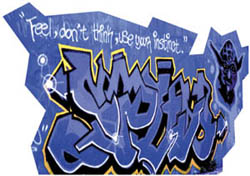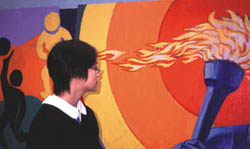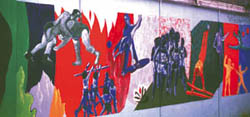 Online
Edition
Online
Edition | From
the editor Letters to the editor Milestone Answerman Periscope Campus Life Social Issues People Photo Features Education Channel Culture & Leisure Science |
| Last
Issue Archive |
| About
Varsity Advertise Media Links CUHK homepage JLM homepage |
Also
in Culture and Leisure
Mahjong
Related Links
Department
of Fine Arts of CUHK
Hong Kong Arts Development Council
![]()
|
Urban
art |
By Germaine Choi
Kids' scribbling on walls always results in punishment. But wall paintings have a proper origin and history to be tracked.
Mural art is a more formal style of wall painting and it has a long history.
The two forms of murals -painting and relief - are considered the earliest forms of murals.
Nonetheless, they were mainly for recording important events or convehing religious themes of the times. They were functional rather then artistic.
Gradually, the European nobility began to use murals for decoration. Murals then became common in grand architecture and churches.
Murals are regarded as a formal and elegant kind of art.
In contrast, graffiti has only a short history. It is regarded as street culture.
It originated in the neighbourhoods of Brooklyn and the Bronx in New York City in the 1960s and 1970s.
It is considered the expression of an anti-social and rebellious subculture.
At first, graffiti artists merely used black markers or spray paint to write simple messages on the walls.
Their works then evolved into the more elaborate "bubble letters", as they now are known.
Modern graffiti has been incorporated into hip-hop culture.
According to Prof. Chan Yuk-shing, professor in the Fine Arts Department at The Chinese University of Hong Kong, the most distinguishing difference between the two art forms is the immediacy of graffiti.
Said Prof. Chan: "Graffiti artists seldom properly design their work before painting. They do not choose a specific site.
"In contrast, muralists consider the correlation between the site and their art."
Besides, since graffiti artists have to finish their work within a short period of time, their paintings are relatively simple.
Said Prof. Chan: "Graffiti is mainly text and seldom has graphics. Details are not shown. But text is rarely used in murals."
Neither murals nor graffiti are common in Hong Kong, but they have gained popularity in recent years, for different reasons.
Most murals in Hong Kong are educational. They are usually about road safety, cleanliness, or anti-crime campaigns.
"Mural art has been transformed into a community art in Hong Kong," said Prof. Chan.
However, Miss Rebecca Tam, a local muralist, thinks that themes for murals in Hong Kong are quite limited.
Said she: "Unlike in the U. S., it seems that there is a lack of political murals here.
"Sometimes people regard issues as too political to be discussed in public, even though they are dissatisfied."
Mural art is strongly supported by the community for its social functions.
The Hong Kong Mural Society is a non-profit organisation founded by artist Kong Ho in June 1997.
Said Joel Eugenio E. Ferraris, member of the Hong Kong Mural Society: "We promote mural art with professional quality through mural production, education and appreciation."
It organised an estate mural painting campaign with the Hong Kong Housing Authority and the Hong Kong Arts Development Council in 1998.
This project was the first of its kind in Hong Kong.
Also, it launched its Muralists-in-Schools Project with 12 secondary schools in 1999.
It brought the project to another 12 secondary schools in 2000.
New Asia Middle School was one of the schools that joined the project.
Lui Wai-chu, an art teacher in New Asia Middle School, said, "Mural painting can express concepts, and it has its social function at the same time."
Miss Lui said that most students had not painted murals before. But some of her students made some attempts on the playground in 1996.
The students showed great interest and devoted much time to the project.
It took them nearly 2 months to finish the whole painting.
Miss Lui said that painting murals in schools faces a number of restrictions.
"The topic must be wholesome," she said. "We have to consider the audience in the schools as well."
Due to the rising popularity of hip-hop culture, more people are interested in graffiti.
Mr. Sam Chan, 17, is a freelance graffiti artist.
He has been drawing graffiti for 3 years. Recently he became the champion the Mi-Graffiti competition, a graffiti painting contest.
He said the development of graffiti faces many obstacles.
"Graffiti painting requires a lot of space. Also there aren't many desirable places," said Mr. Chan.
Concerning the development of these two art forms in Hong Kong, opinions diverge.
Mr. Ferraris of the Hong Kong Mural Society said "a reservoir of talent" in mural art exists in school workshops.
"These future artists could change the faces of dull, blank walls to tourist spots," he said.
Mr. Adolph Wan is a former graffitti artist.
Said Mr. Wan: "I think the trend of graffiti will keep on without declining."
Prof. Chan at The Chinese University of Hong Kong said murals will become more popular because they have a social function.
However, he said the trend of drawing graffiti will not last.
"Graffiti is a by-product of hip-hop culture rather than an independent art here," said Prof. Chan.
"When hip-hop culture is no longer popular, graffiti art will fade as well."
This is to say nothing about the fact that drawing graffiti is illegal.
Scofflaws can be charged with a criminal offence.
Said Mr. Wan: "I can't afford the time to make drafts.
"Besides, one of my friends got caught for drawing graffiti."
That is why Mr. Wan and his friends ask someone to act as a lookout every time they paint.
Mr. Ferraris said graffiti is "exciting and appeals strongly to the younger generation".
However, he said teenagers might possibly go out of control and mess up the neighbourhood.
He also pointed out that the sprays used in graffiti painting are not environmentally friendly.
The gases emitted can impose hazards.
"If the youth of Hong Kong really insist on trying their hand at graffiti, the government should provide a graffiti wall where air pollution is strictly checked," he said.
Mr. Sam Chan, a graffiti artist, disagreed.
"Graffiti will ruin the environment only if the artists have not acquired the skills beforehand.
"Otherwise,
it can also beautify Hong Kong, just as other art forms do," he said.
![]()
 Graffiti is unique for its immediacy and simplicity. |
|
Germaine
Choi
 Students are a reservoir of talent for painting murals. |
|
Germaine
Choi
 In Hong Kong, the themes of murals tend to be educational rather than political. |